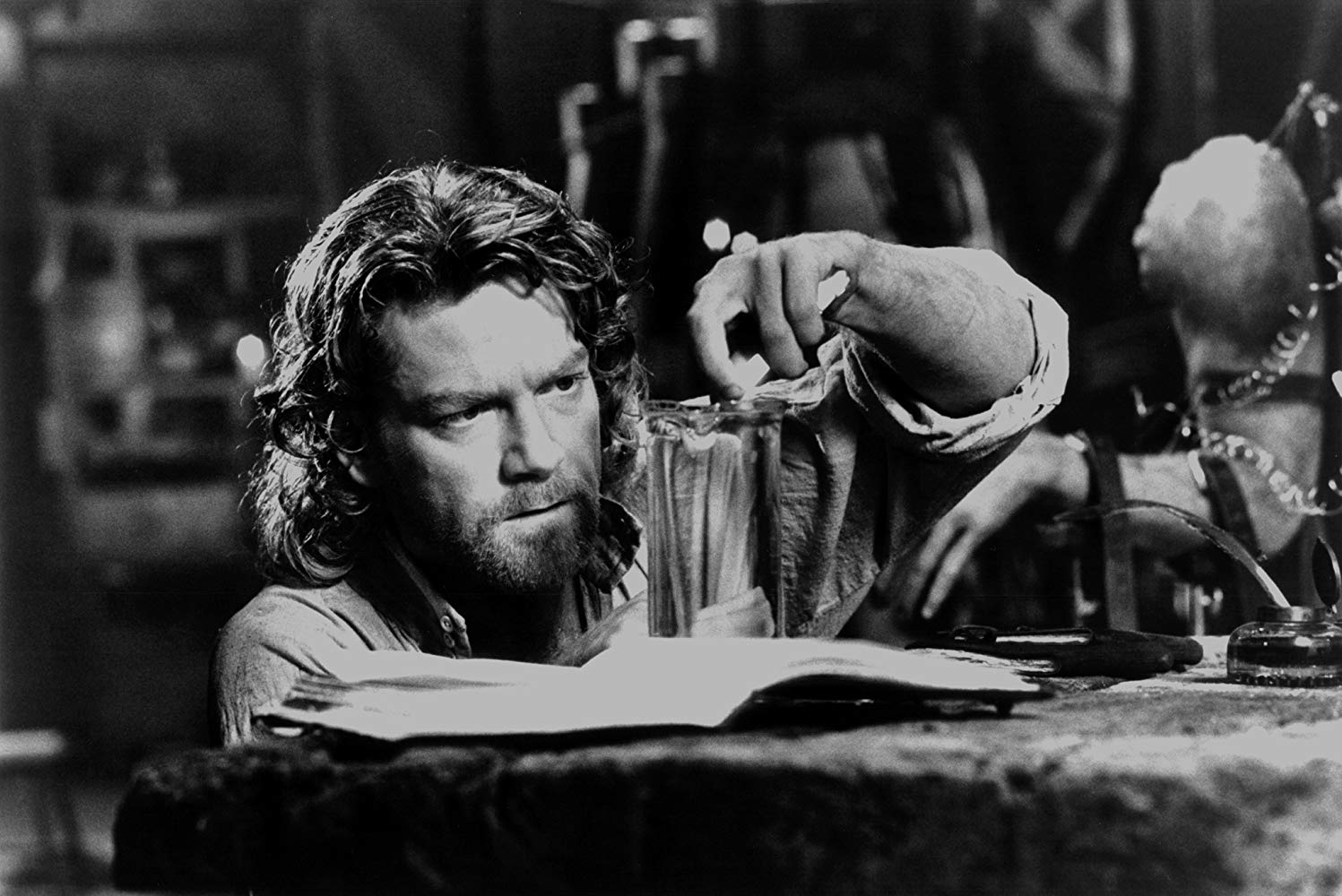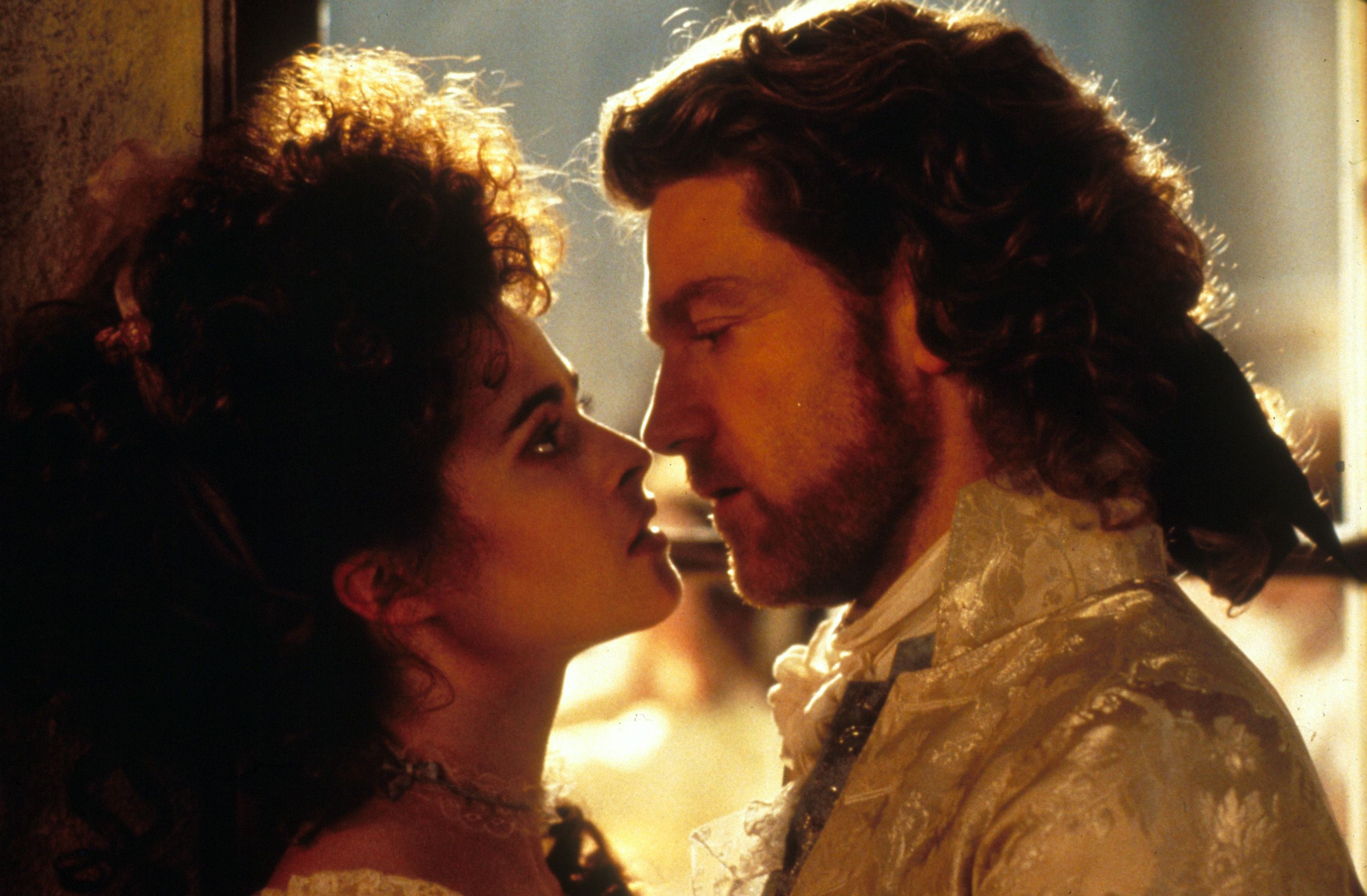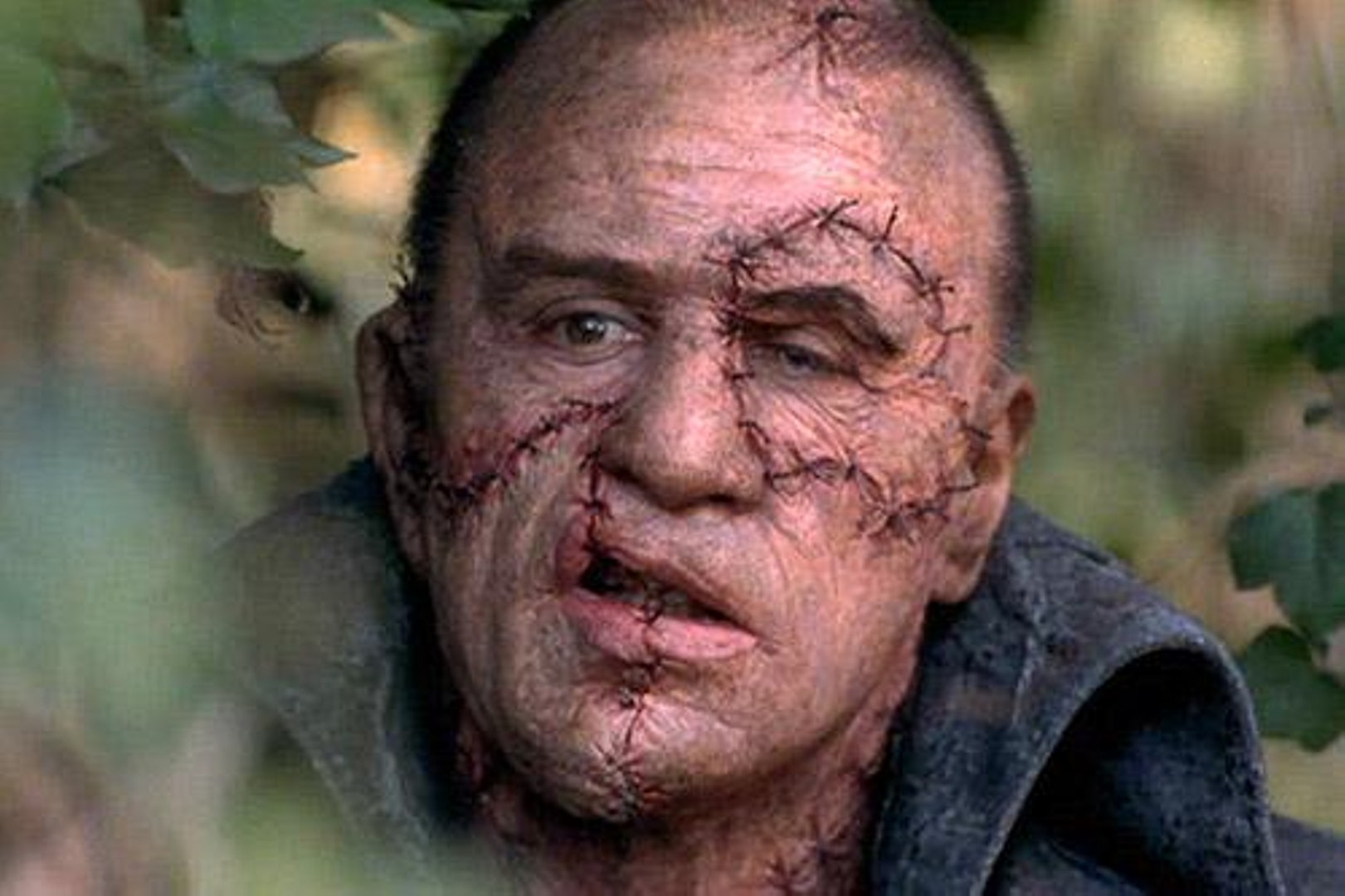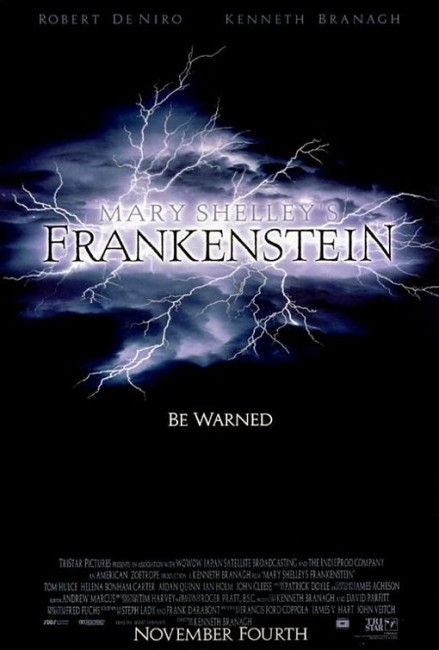USA/Japan. 1994.
Crew
Director – Kenneth Branagh, Screenplay – Frank Darabont & Steph Lady, Based on the Novel by Mary Shelley, Producers – Francis Ford Coppola, James V. Hart & John Veitch, Photography – Roger Pratt, Music – Patrick Doyle, Visual Effects Supervisor – Richard Conway, Digital Effects – The Computer Film Co Ltd, Makeup Effects Supervisor – Daniel Parker, Production Design – Tim Harvey. Production Company – Tristar/Japan Satellite Broadcasting/Indie Prod Co/American Zoetrope.
Cast
Kenneth Branagh (Dr Victor Frankenstein), Robert De Niro (The Creature), Helena Bonham Carter (Elizabeth), Tom Hulce (Henry Clerval), John Cleese (Professor Waldham), Aidan Quinn (Captain Robert Walton), Ian Holm (Alphonse Frankenstein), Trevyn McDowell (Justine Moritz), Richard Briers (Grandfather), Cherie Lunghi (Caroline Frankenstein), Robert Hardy (Dr Krempe)
Plot
1794. A sailing ship exploring the North Pole is grounded on the icepack. There the crew encounter a madman who introduces himself as Victor Frankenstein and tells the captain an incredible story. The son of a wealthy Geneva doctor, he entered medical school where he became fascinated with the theories of Professor Waldman who claimed to be able to reactivate lifeforce by electrical stimulation of the Chinese acupuncture points. After Waldman’s death, Victor took his notebooks and successfully revived a body from the dead but ran away shocked at what he had done. The creature survived and learned to speak by listening in on a family living in the forest. It then returned to Frankenstein, killing his younger brother and tormenting Victor until he promised to create a mate for it.
Film productions of Dracula and Frankenstein always seem to operate as yin and yang – when a new version of one is made, the other seems certain to follow. The success of the Universal Dracula (1931) with Bela Lugosi was quickly followed by the Boris Karloff Frankenstein (1931); Hammer’s The Curse of Frankenstein (1957) gave birth to their Dracula/The Horror of Dracula (1958) soon after; Andy Warhol’s Frankenstein (1973) quickly begat Andy Warhol’s Dracula (1973) with fairly much the same cast and crew; Dan Curtis’s made a tv version of Frankenstein (1973) and followed it with the Jack Palance Dracula (1974).
In like vein, Mary Shelley’s Frankenstein has been designed as companion piece to Francis Ford Coppola’s visually sensational Bram Stoker’s Dracula (1992). This time Francis Ford Coppola only serves as producer rather than director, while Dracula‘s screenwriter James V. Hart returns as producer. Both versions are the highest-budgeted production of either story and lay some claim to being filmed ‘as the book was written’, evidenced by their somewhat pompous titular claim to authorial validation.
Despite a noble attempt, Mary Shelley’s Frankenstein fails to quite come off. At just over two hours, the film feels overlong. It is wordy and the pace drags in many scenes. Part of the problem is the story’s familiarity. The build-up with Frankenstein’s trip to Vienna, his meeting with Clerval, his defiance of the medical fraternity, his first hesitant experiments have all been done before – we know where they are heading and the film offers no new spins on the familiar.

In the latter half, the film becomes far more interesting. Here we get plot elements from the book that have not been tried in many previous versions – scenes like the Arctic opening and end; simply the fact that the creature talks and is intelligent and able to express its pain; the sequence of events concerning the killing of William and the creature’s framing of Justine; the creature’s compelling Frankenstein to create it a mate to ease its loneliness. This is one of the few adaptations of the book to get the relationship between the creator and creation right – emphasizing the creature’s loneliness, its rejection from society, its haunted quest for a soul, its desire for a mate, and Frankenstein’s craven running away from his creation and ensuingly being forced to take responsibility for it.
Some details have been changed – the events of the latter half of the book have been telescoped down, Clerval is not killed by the creature and Frankenstein does not go all the way to the Orkneys to create the monster’s mate. The biggest change occurs in the latter third where Frankenstein, unlike in the book, does end up creating a female creature. Here the film imports some of Bride of Frankenstein (1935) and in an intriguing move has Frankenstein reviving a murdered Elizabeth from the dead.
There are other subtler changes – at times the film seems to be trying to be a New Age Frankenstein with Frankenstein using acupuncture points to bring dead bodies back to life and arguing that traditional medicine should be balanced out against alchemists like Albert Magnus and Paracelsus. (Although some modern medicine does sneak in – Frankenstein is seen attempt CPR on the dead Waldman well before the technique was actually invented).

The film’s trailer edited glimpses of the film into a fabulously sensual, superbly scored Gothic montage. Sadly, director Kenneth Branagh’s actual visual style is unexciting. The creation scene, which takes place in a brass pressure cooker-come-bath, is lacking in any of the fabulous excitement of the laboratory sequences in either the Universal or Hammer Frankenstein’s. There are some interesting sets – like the medical lecture hall built round an improbably tight concentric spiral pit. The most striking set is the giant staircase inside the Frankenstein house, which sweeps starkly up around two walls – it suggests the stylized sets of the James Whale Frankenstein. There is one beautiful shot where Frankenstein carries Elizabeth’s dead body up the staircase, the long red train of her dress trailing behind her, otherwise Kenneth Branagh uses the set as though it were just part of the background and spends all his time absorbed in fidgety camera swoops in the foreground. Branagh did a sterling job on the Shakespeare adaptations that brought him to attention as a director – Henry V (1989), Much Ado About Nothing (1993) and Hamlet (1996) – however as Frankenstein demonstrates, he is all epic dynamism, but where the story seems hollow, his work seems stretched too large for the stage that contains it.
The influence of the Coppola Dracula does at times seem to be trying to force the Frankenstein story into being something it isn’t. Kenneth Branagh tries to conduct the film with the ostentatious, visually ravishing sensuality that fired Coppola’s Dracula up. Unfortunately, Frankenstein is not a story that readily lends itself to sensual undertows – it is after all about human bodies being cut up and a creature so scarred and hideous that he is repulsive to society – not ready material for erotic cinematography. Branagh naturally gets to bring the creature to life while bared to the waist and covered in sweat. The most bizarre scene is one that goes on for several minutes with a semi-stripped Branagh and a nude Robert De Niro struggling around on the floor in a mass of KY jelly, a scene that seems to be inserted for no purpose other than to allow the audience to contemplate the homoerotic possibilities it may offer – two naked men and a lot of KY jelly, what else is an audience supposed to interpret it as?
As an actor, Kenneth Branagh began life with the Royal Shakespeare Company. Branagh works best when he gives his himself larger-than-life roles such as the sort that his Shakespearean adaptations naturally lend themself to. In straight acting roles, Branagh is not as capable of a finer range of inner emotions, he always seems fired up with theatrical passion. Here he gives the role of Frankenstein a suitable intensity but little more than that.

One had horrifying thoughts when one heard of the casting of Robert De Niro as the creature – that the monster would wander through the film taunting its creator with De Niro’s characteristic lopsided smirk and twinkle of eyes. Thankfully, that is not the case, although some of De Niro’s scenes do seem to be painfully method acted. His scenes with Richard Briers’ blind hermit learning the word ‘friend’ do evince an authentic pain. The casting of comedy actor John Cleese in a Frankenstein film seemed a bizarre choice but Cleese – almost unrecognizable in long white hair and beard – subsumes his funny man persona to create an effective Waldman.
Kenneth Branagh’s other genre films as director are:- the reincarnation thriller Dead Again (1991); the Shakespeare adaptation Hamlet (1996); the modernised adaptation of the Mozart opera The Magic Flute (2006); the Marvel Comics superhero adaptation Thor (2011); the reboot of the Tom Clancy series Jack Ryan: Shadow Recruit (2014); the big screen adaptation of Cinderella (2015); and the Young Adult adaptation Artemis Fowl (2020).
Other Frankenstein adaptations are:– Frankenstein (1910), the silent adaptation produced by Thomas Edison; Universal’s Frankenstein (1931), the classic adaptation with Boris Karloff, which spawned six sequels; Hammer’s The Curse of Frankenstein (1957) with Peter Cushing as the Baron and Christopher Lee as the monster, which also spawned six sequels; Hammer’s comic remake The Horror of Frankenstein (1970) with Ralph Bates as the Baron and Dave Prowse as the monster; Frankenstein (tv movie, 1973) starring Robert Foxworth as the Baron and Bo Svenson as the monster; Frankenstein: The True Story (1974), a lush British tv mini-series starring Leonard Whiting as the Baron and Michael Sarrazin as the creature; the Swedish-Irish production Victor Frankenstein (1977) with Leon Vitali as Frankenstein and Per Oscarsson as the monster; Frankenstein (1984), with Robert Powell as the Baron and David Warner as the monster; the little-seen tv movie Frankenstein (1986) with Carl Beck as Frankenstein and Chris Sarandon as the monster; David Wickes’s dreary tv movie Frankenstein (1992) with Patrick Bergin as the Baron and Randy Quaid as the monster; the tv mini-series Frankenstein (2004) with Alec Newman as Frankenstein and Luke Goss as the monster; Danny Boyle’s stage version of Frankenstein (2011) with Benedict Cumberbatch and Jonny Lee Miller alternating the role of Frankenstein and creation; the low-budget Frankenstein: Day of the Beast (2011) with Adam Stephenson as Frankenstein and Tim Krueger as the monster; and Victor Frankenstein (2015) with James McAvoy as Frankenstein.
(Nominee for Best Supporting Actor (Robert De Niro), Best Musical Score, Best Makeup Effects and Best Production Design at this site’s Best of 1994 Awards).
Trailer here


